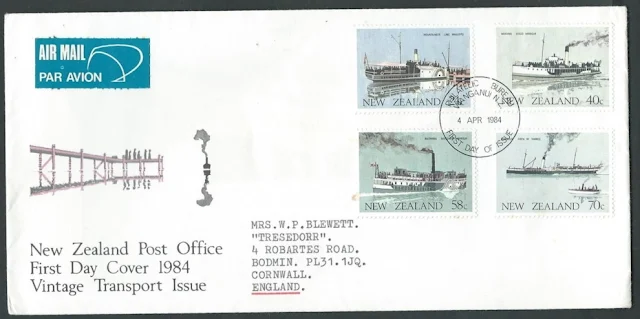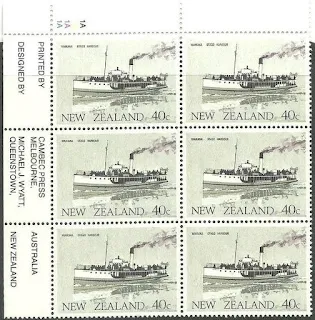During the 1980s NZ Post released three stamp issues with vintage transport themes. We have decided to combine these on a single page for ease of viewing and comparing the three sets. The first, featuring passenger ferries, was issued in 1984; the second, featuring trams, was issued in 1985; the third, came in 1986, featuring motorcycles.
Water travel was the easiest mode of transport for the early pioneers. But sailing craft were slow and uncertain. During the early 1840s, passengers, mail and cargo were consistently delayed and lives were being lost. The advent of steam in the mid-1800s made water communication swift, regular, feasible and safe. The first truly successful application of mechanical power was the paddle wheel. The splash and patter of the paddles was soon to be seen and heard around New Zealand coasts, harbours, lakes and rivers. Progress has meant the paddle steamer has been superseded, both on the water and by land transport, except for the occasional preserved pleasure craft.
The vintage ferry issue recalls the contribution made by passenger ferries to the development of parts of New Zealand. Consisting of four stamps, the set features two ferries which served gold mining settlements and two commuter ferries which operated on city harbours.
Ferries. Trams. Motorcycles.
You may wish to view the earlier 1970s Vintage Transport Issues.
1984 Vintage Transport - Passenger Ferries.
Water travel was the easiest mode of transport for the early pioneers. But sailing craft were slow and uncertain. During the early 1840s, passengers, mail and cargo were consistently delayed and lives were being lost. The advent of steam in the mid-1800s made water communication swift, regular, feasible and safe. The first truly successful application of mechanical power was the paddle wheel. The splash and patter of the paddles was soon to be seen and heard around New Zealand coasts, harbours, lakes and rivers. Progress has meant the paddle steamer has been superseded, both on the water and by land transport, except for the occasional preserved pleasure craft.
The vintage ferry issue recalls the contribution made by passenger ferries to the development of parts of New Zealand. Consisting of four stamps, the set features two ferries which served gold mining settlements and two commuter ferries which operated on city harbours.
24c - Mountaineer - Lake Wakatipu.
The Mountaineer was built in Dunedin before being shipped in a knock-down state to Bluff and then railed to Kingston for assembly. Launched in 1879 the Mountaineer connected the railhead at Kingston on Lake Wakatipu with Queenstown and its associated gold fields.
40c - Waikana - Otago Harbour.
The Waikana was built in Dunedin and launched in 1909. She provided the link between the growing heart of Dunedin and its outlying harbour settlements and was used often for picnics and other excursions at weekends.
58c - Britannia - Waitemata Harbour.
The Britannia was built in Auckland in 1885 and continued in service until 1927 when she was sold as a houseboat and subsequently broken up for her timbers.
70c - Wakatere - Firth of Thames.
The Wakatere was built in Scotland and arrived in Auckland in 1896. She was the link between the Thames goldfields and Auckland, steaming along the Firth of Thames and serving this run until 1926.
First Day Cover.
Plate Blocks.
1985 Vintage Transport - Trams.
Tram-cars reigned supreme in New Zealand streets for longer than any other public vehicle. There were weather-beaten drivers holding tightly to their reins, grippers or control handles. There were the many different conductors collecting fares, and during wartime, there were the women who stepped in to help out.
All served New Zealand and New Zealanders over the years, delivering people to their homes, businesses and recreational activities. The public, in turn, became attached to these structures of wood and steel that gave everyone the freedom of the cities before the days of the all-conquering automobile.
All served New Zealand and New Zealanders over the years, delivering people to their homes, businesses and recreational activities. The public, in turn, became attached to these structures of wood and steel that gave everyone the freedom of the cities before the days of the all-conquering automobile.
24c - Nelson Horse-Drawn Tram - 1862.
Nelson developed the first passenger street tramway. A single horse pulled the coach-style tram along 1.6 kilometres of line from the city centre to the Port of Nelson. The initial sixpenny fare was dropped to threepence to encourage greater use after pranksters laying stones on the rails caused derailments. In 1901 the service was bought by the Town Council but the cost of modernisation and electrification proved too much and the tramway was dismantled and removed.
30c - Graham's Town Steam Tram - 1871.
One of the earliest locally-built tram carriages was made of that most famous of New Zealand timbers, kauri. Its short career had a rather inauspicious beginning. The discovery of gold at Graham's Town (now Thames) meant many passengers for the country's first steam tramway opened in 1871. The track ran from Thames to the deep-sea wharf at Tararu Point. In May 1874 a heavy gale partly destroyed the wharf and washed away a large section of the tramway. The damage was so great both the wharf and tramway were abandoned. The line closed on 10 November 1874.
35c - Dunedin Cable Car - 1881.
New Zealand's first cable cars appeared in Dunedin and came to be widely utilised there. The Rattray Street cable tramway was the first to operate outside the United States of America. In the days when horses and steam were the only recognised means of vehicle power, the sight of cable cars climbing the steep hills without visible means of power was awe-inspiring. The cables were laid in tunnels beneath the road.
40c - Auckland Electric Tram - 1902.
Although Dunedin had the first electrics, Auckland was the first to go for a complete electric system and the novelty of the horseless tramcars attracted 15,000 passengers at twopence a ride on its first day in service. Being cheaper and quicker than the horse-drawn trams, Auckland became a community of tram-riders.
45c - Wellington Electric Tram - 1904.
Wellington's first electric tram was a single track, double-decker tram which ran for the first time from the Newtown tram sheds to Kent Terrace on 30 June 1904. Brilliantly lit, the tram came slowly and steadily down the track accompanied by frequent flashes of electricity - the spectacle was unique and fascinated the population.
58c - Christchurch Electric Tram - 1905.
Depicted on this stamp is a 1905 Christchurch tram towing a trailer from Cathedral Square. Early trams incorporated large spring-loaded steel fenders mounted front and rear to protect cyclists and pedestrians. Electric heaters were installed under each seat and winter travellers were often reluctant to leave their warm haven. Yet unlike the Wellington system, seats were uncushioned, management considering cushioned seats unhygienic.
First Day Cover.
Colour Shift Error.
A colour shift of the red has caused the whole image to appear blurred and doubled.
1986 Vintage Transport - Motorcycles.
The early motor bicycles were commonly referred to as 'motor-assisted bicycles', and in effect, that is what they were. Pedal power was required to get them started until the engine could take over. Through research and a lot of trial and error, a successful 2-wheeled motorcycle was eventually produced; one that offered safe, fast, healthy and personal transport. Modern riders, influenced by the latest models from overseas, would not hesitate to describe these early motorcycles as museum pieces. Yet, by their sturdiness in coping with rough conditions, and the years of reliable and pleasurable service they gave to their owners, these machines have earned a high ranking in the annals of this country's early transport. The motorcycles shown on the four stamps of this issue are indeed a far cry from the sleekly-designed sophisticated machines we see on today's roads.
35c - 1000cc Indian Power Plus - 1920.
A typical, big, rugged American motorcycle built for long-distance running over arduous roads, Popularly known as the 'spring frame' Indian, it was one of the first motorcycles to have a sprung rear wheel. Many were supplied to the police and military forces.
45c - 500cc Norton - 1927.
With major racing successes in the Isle of Man, this reliable British motorcycle earned great fame in the racing and sports world.
60c - 500cc BSA - 1930.
Made by the "Birmingham Small Arms" Company and bearing the logo of three rifles stacked in a pyramid. This was later changed to emphasise the letters BSA. One of their most popular models was the 1930 BSA 'Sloper'.
75c - 550cc Triumph - 1915.
In World War I, the Triumph was exclusively used by British Army dispatch-riders, earning the nickname the 'trusty' Triumph. Thirty thousand of these machines were supplied to the British and Allied armies.
First Day Cover.
Technical information - Vintage Ferries.
Date of Issue:
|
4 April 1984
|
|---|---|
Designer:
|
M Wyatt, Queenstown
|
Printers:
|
Cambec Press, Australia
|
Stamp Size:
|
42mm x 30mm
|
Sheet Size:
|
100 stamps per sheet
|
Process:
|
Lithography
|
Perforation Gauge:
|
13.6 x 13.2
|
Paper Type:
|
Unwatermarked
|
Technical information - Vintage Trams.
Date of Issue:
|
6 March 1985
|
|---|---|
Designers:
|
R M Conly, Waikanae
|
Printers:
|
Cambec Press, Australia
|
Stamp Size:
|
42mm x 30mm
|
Sheet Size:
|
100 stamps per sheet
|
Process:
|
Lithography
|
Perforation Gauge:
|
13.5 x 13.25
|
Paper Type:
|
Unwatermarked
|
Technical information - Vintage Motorcycles.
Date of Issue:
|
5 March 1986
|
|---|---|
Designers:
|
M Wyatt, Queenstown
|
Printers:
|
Waddington Security Print, England
|
Stamp Size:
|
42mm x 28mm
|
Sheet Size:
|
100 stamps per sheet
|
Process:
|
Lithography
|
Perforation Gauge:
|
13 x 12.5
|
Paper Type:
|
Unwatermarked
|
Some of the images in this post were used with permission from the illustrated catalogue of StampsNZ
You can visit their website and On-line Catalogue at, http://stampsnz.com/
Information for this post came from.

























We appreciate your engagement with our content. To ensure a respectful and constructive community, please take note of the following:
- No Spam, Please: We do not tolerate spammy or promotional comments. Any such comments will be promptly removed.
- Moderation in Place: All comments are moderated to maintain a positive and inclusive environment. Please be patient, as it may take a little time for your comment to appear.
- Sign In with Google: To comment, please sign in using your Google account. This helps us maintain the integrity of our community and allows for better interaction.